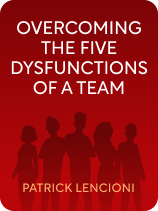

This article is an excerpt from the Shortform book guide to "Overcoming the Five Dysfunctions of a Team" by Patrick Lencioni. Shortform has the world's best summaries and analyses of books you should be reading.
Like this article? Sign up for a free trial here.
Are your team members more interested in their personal success than the team’s success? If so, what can be done about it?
Patrick Lencioni identifies inattention to results as the fifth dysfunction of a team. He argues that employees too often direct their attention toward their own interests at the expense of the team’s interests.
Keep reading to learn how to get your team to focus on results instead of themselves.
Focus on Results
The avoidance of accountability (Dysfunction #4) hinders teamwork because people are too concerned about hurting their teammates; self-interest hinders teamwork when people go too far in the other direction and aren’t concerned enough about their teammates and the team’s health and performance.
Lencioni says that people are naturally self-centered, and, as a result, they lose sight of the big picture: company outcomes. We’ll briefly examine a few ways that self-interested behavior can harm the team and the company. We’ll then discuss his advice on how to get the team to focus on results and keep their attention there.
The Problems With Self-Interested Behavior
Self-interested behavior can have several negative impacts on companies and teams. First, Lencioni notes that people might resist ideas that hinder their personal goals, even if those ideas are good for the company as a whole. For example, if the team decides to hire an outside expert to fill an advisory role that a less experienced team member was hoping to get, the team member in question would likely oppose that idea.
Team members may also sometimes suffer from tunnel vision—focusing too heavily on their own work or their own department—and may not take into account how the company as a whole is performing. For instance, if the manager of a manufacturing team is having the team cut corners to produce vast amounts of a product, that manager’s personal metrics might look exceptional. However, their team’s shoddy work will harm the company in the long run when customers realize that their products are of poor quality.
Finally, self-interest may give rise to egotism, where one team member thinks they’re more important or more capable than the team as a whole. Lencioni notes that this is especially common with top performers, whose exceptional work often shields them from the consequences of bad behavior and rule-breaking. However, he says that no one person—no matter how good they are at their job—is more important than the team. Therefore, anyone who can’t let go of ego and commit to the group should be removed from it. You’ll find that the team’s improved overall performance more than makes up for the loss of one top performer, leading to better outcomes for the company as a whole.
| A Company Is All One System You can address all of the problems stemming from self-interest by encouraging your team to understand the big picture: the company as a whole. As systems scientist Peter Senge explains in The Fifth Discipline, self-interested people make the mistake of viewing a company as a collection of disconnected parts: individual departments, or even individual employees. Instead, Senge urges you to see an organization as a single cohesive system where every part influences every other part and to help your coworkers (or teammates, in this case) see it that way as well. For the team member who resists hiring an outside expert for a role they hoped to fill themselves, you might point out that a specialist could produce better outcomes—and higher profits—for the company as a whole, which will then be reflected in that team member’s salary or bonus. Alternatively, you could argue that taking on a new role will hinder or eliminate that person’s ability to perform in their current role. That could harm the company, the team, and the team member in question. For the team member who’s having their workers cut corners to make products more quickly, point out that it won’t matter how quickly they can produce if their goods gain a bad reputation and nobody wants to buy them. Also, help them see how one shoddy product harms the company’s reputation—and its bottom line—which will end up hurting everyone who works for that company. The egotistical top performer needs to understand that they’re just one tiny part of a much larger system and that their behavior is harming that system, regardless of how good their individual metrics are. To use a metaphor, their selfishness is like sand in the gears of your corporate machine; it slows and irritates everyone around them, making the entire system less efficient. This eventually comes back to hurt the star performer as well. |
How to Keep the Team Focused on Results
To shift people’s focus off themselves and onto overall outcomes, Lencioni suggests choosing and visibly tracking one or two company metrics related to the team’s overall goal. You’ll be constantly reminding your team of their big-picture goals and letting them see their progress toward those goals. For example, you might maintain a shared online document or write the chosen metrics on a whiteboard before each team meeting.
Note that the metrics you choose must be objective and measurable, such as sales numbers or customer reviews. In other words, set a simple and concrete goal for your team to reach, and track appropriate metrics to keep each team member focused on that goal.
| Set Intermediate Goals, and Celebrate Meeting Them Lencioni urges you to track your team’s progress to keep people motivated and focused. In Leading Change, leadership expert John P. Kotter says you can make this practice even more effective by setting short-term goals or milestones leading up to that main goal—tracked using the same metrics—and celebrating with your team when you pass each milestone. For example, if your final goal is to sell 1,000 of a certain product each month, you might celebrate when your monthly sales reach 250, 500, and 750. Those small victories will make sure your team stays engaged and encouraged as they work toward their big-picture goal. This practice will also help ensure that you’ve chosen an appropriate big-picture goal; if your final goal isn’t simple, concrete, and measurable, it will be extremely hard to identify actionable steps that lead up to it. |

———End of Preview———
Like what you just read? Read the rest of the world's best book summary and analysis of Patrick Lencioni's "Overcoming the Five Dysfunctions of a Team" at Shortform.
Here's what you'll find in our full Overcoming the Five Dysfunctions of a Team summary:
- What "teamwork" actually means, and how to foster it
- Why trust is the most important element in an effective team
- The five impairments to teamwork and how to overcome them






